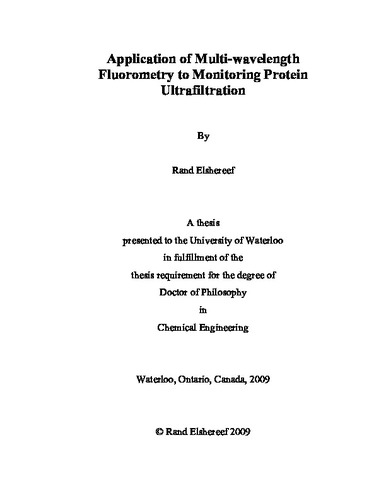| dc.description.abstract | Membrane filtration of protein solutions is influenced by a wide range of processing
and physicochemical conditions. Monitoring and optimizing membrane filtration may
have advantages for achieving, in a cost effective manner, improved bioproduct
purification and membrane performance which is relevant to pharmaceutical and
biochemical applications. The motivation of this work was to examine the feasibility of
applying two-dimensional fluorescence spectroscopy in conjunction with chemometric
techniques for monitoring and possibly optimizing the performance of membrane
processes.
Preliminary work focused on assessing the use of multivariate calibration tools in
conjunction with the sensitivity of intrinsic protein fluorescence towards changes in
environmental conditions was to predict protein concentration and aggregation
behavior. A model protein, β-lactoglobulin (β-LG), was used as a first simple case
scenario. Results showed very good agreement between the fluorescence based
predictions and measurements obtained by HPLC and gravimetric analysis regardless
of the conditions. PLS analysis of excitation-emission matrices revealed unique
spectral fingerprints that are most likely associated with the heat-induced denaturation
and aggregation. Standard Normal Variate, a signal preprocessing and filtering tool,
was shown to have a significant effect on enhancing the predictive accuracy and
robustness of the PLS model as it reduced the effect of instrumental noise. The
methodology was then extended to a two-component protein system consisting of α-
lactlalbumin (α-LA) and β-lactoglobulin (β-LG). The process of thermal induced
aggregation of β-LG and α-LA protein in mixtures, which involves the disappearance
of native-like proteins, was studied under various treatment conditions including
different temperatures, pH, total initial protein concentration and proportions of α-LA
and β-LG. A Partial Least Squares (PLS) regression algorithm was used to correlate
the concentrations of α-LA and β-LG to the fluorescence spectra obtained for mixtures.The results illustrated that multivariate models could effectively deconvolute multiwavelength
fluorescence spectra collected for the protein mixtures and thereby provide
a fairly accurate quantification of respective native-like α-LA and β-LG despite the
significant overlap between their emission profiles. It was also demonstrated that a PLS
model could be used as a black-box prediction tool for estimating protein aggregation
when combined with simple mass balances.
Ultrafiltration experiments of the whey protein isolate solutions were carried out in
dead-end filtration mode and fluorescence measurements of permeate and retentate
solutions were acquired in synchronous scanning mode using a fiber optic probe. By
implementing a dilution strategy for the retentate side, the fluorescence based PLS
model encompassed a low protein concentration range where fluorescence was not
expected to be significantly influenced by concentration-dependent interferences. It
was also demonstrated that synchronous spectra can provide good predictions and
consequently the use of the full spectrum may not be necessary for monitoring with
corresponding savings in acquisition time. Membrane performance variables that are
difficult to measure, such as individual protein transmission and membrane selectivity
could be estimated directly from fluorescence-based predictions of protein
concentrations in the retentate and permeate streams.
Multiwavelength light scattering spectra, acquired using the fiber optic probe, were
shown to be a useful indicator for protein self-association behavior, which is known to
influence the membrane filtration. High fouling potential were observed for protein
solutions that exhibited significant Rayleigh scattering. A predictive PLS model for
estimating protein aggregation from Rayleigh scattering measurements was developed
and it was tested by using molecular weight experimental values obtained from the
literature. Although this comparison was only partial due to the limited amount of
molecular weight data available, the findings verified the possibility of estimating the
aggregate size from multiwavelength Rayleigh scattering spectra acquired using a
conventional spectrofluorometer. Thus, the results implied that both intrinsic fluorescence and light scattering multiwavelength measurements could provide
complementary information about the filtration process. | en |

